16 Things to Do in Mtskheta, Georgia’s Ancient Capital
Mtskheta is Georgia’s spiritual heart and one of the most historic towns in the country. Once the capital of the ancient kingdom and today a UNESCO World Heritage Site, it’s best known for its centuries-old churches and monasteries. Despite its small size, there are enough things to do in Mtskheta to make it the most popular day trip from Tbilisi.
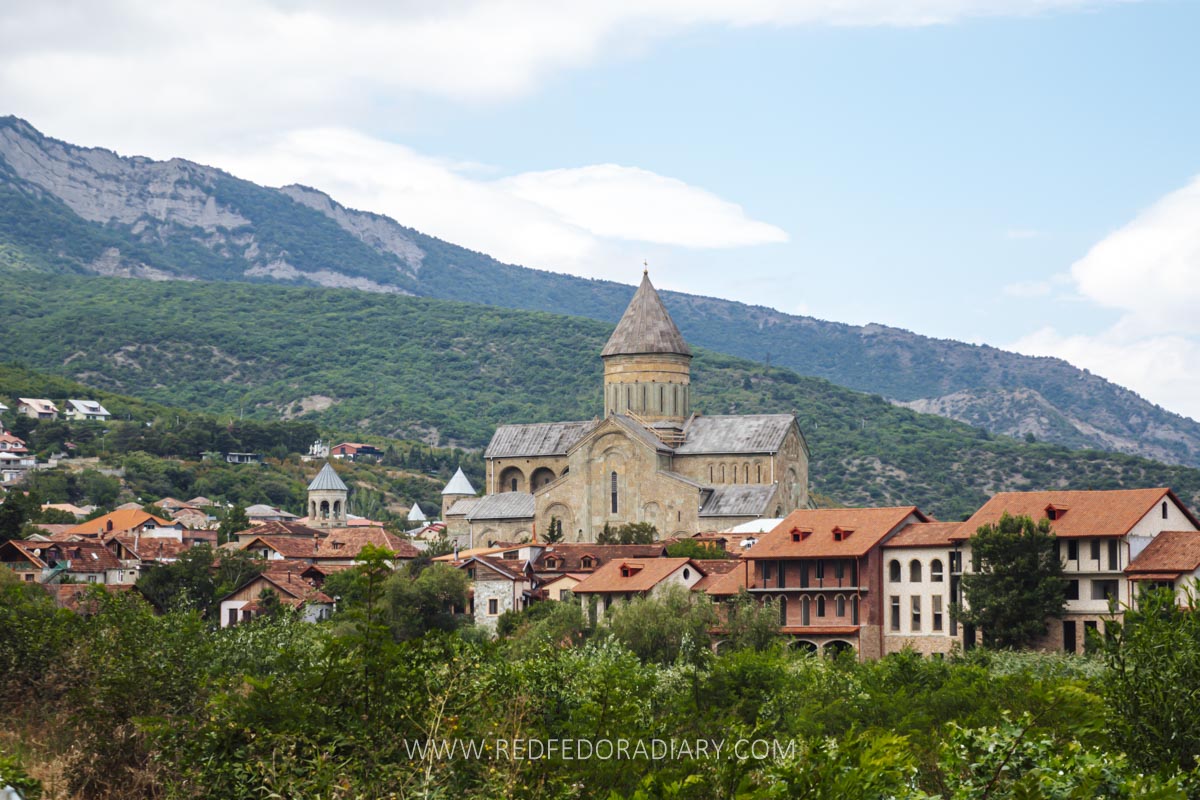
As a local, I’ve been to Mtskheta countless times — sometimes just for a lunch or dinner stopover from Tbilisi or on my way to other destinations, and other times to spend the day exploring its landmarks and quiet backstreets.
In this Mtskheta travel guide, I explain why to add it to your Georgian itinerary, walk you through both the must-see highlights and the more overlooked places around the city.
Moreover, I share practical tips on planning your visit, including the best time to go, how to get there, what to bring, my choice of Mtskheta restaurants and cafes, or hotels in Mtskheta to stay if you decide not to rush back to Tbilisi.
Disclaimer: Some of the links in this post are affiliate links, which means I may earn a small commission if you buy something through them—at no extra cost to you. It helps support my blog and lets me share real, first-hand travel tips. Learn more
Why plan a Mtskheta day trip from Tbilisi
Mtskheta isn’t just another picturesque town near Tbilisi—it’s where Georgia’s history and faith converge. Former capital of the ancient Kingdom of Iberia, the city has been continuously inhabited for thousands of years and is considered the birthplace of Christianity in Georgia. Because of this, Mtskheta was declared a “Holy City” in 2014.
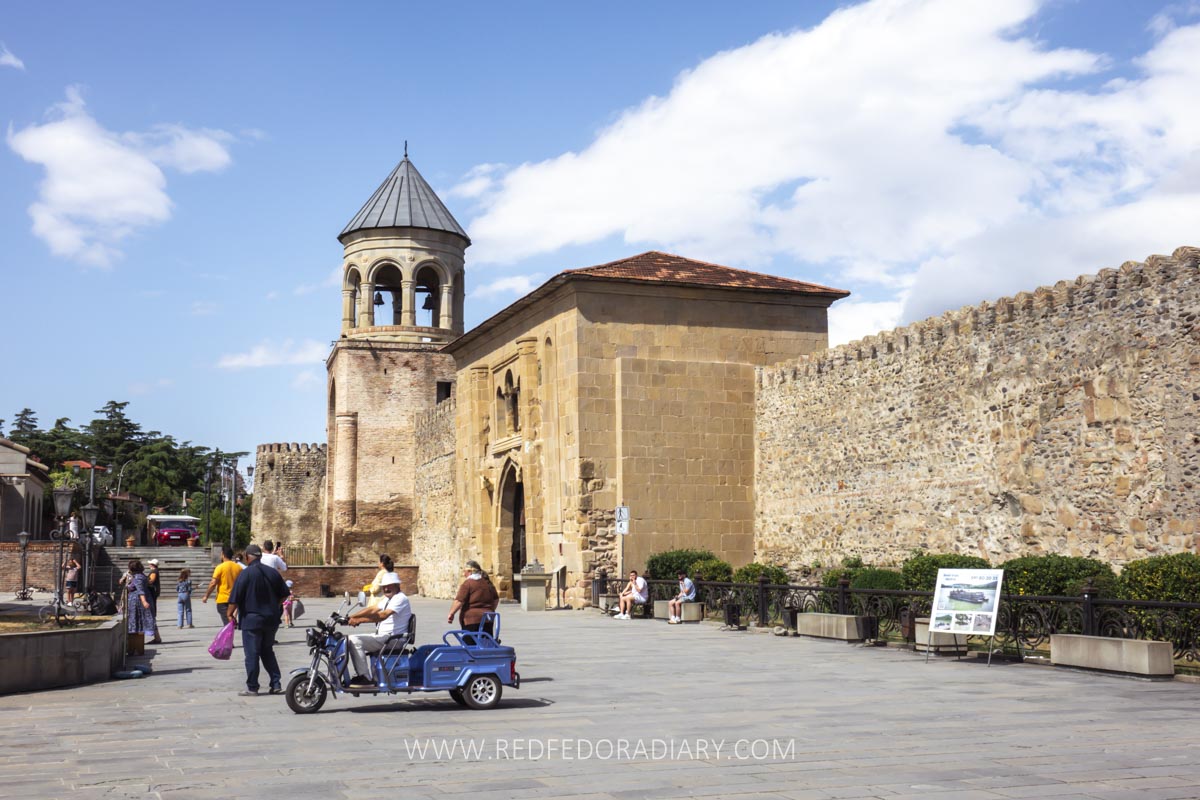
In its early days, Mtskheta was a thriving settlement with distinct neighborhoods, including Armazis Tsikhe, Tsitsamuri, and Jvari, which were divided into the city proper and a fortified citadel.
It also became home to the first Christian communities. According to tradition, Jewish settlers brought the Holy Tunic of Christ here from Jerusalem, adding to the city’s growing spiritual significance.
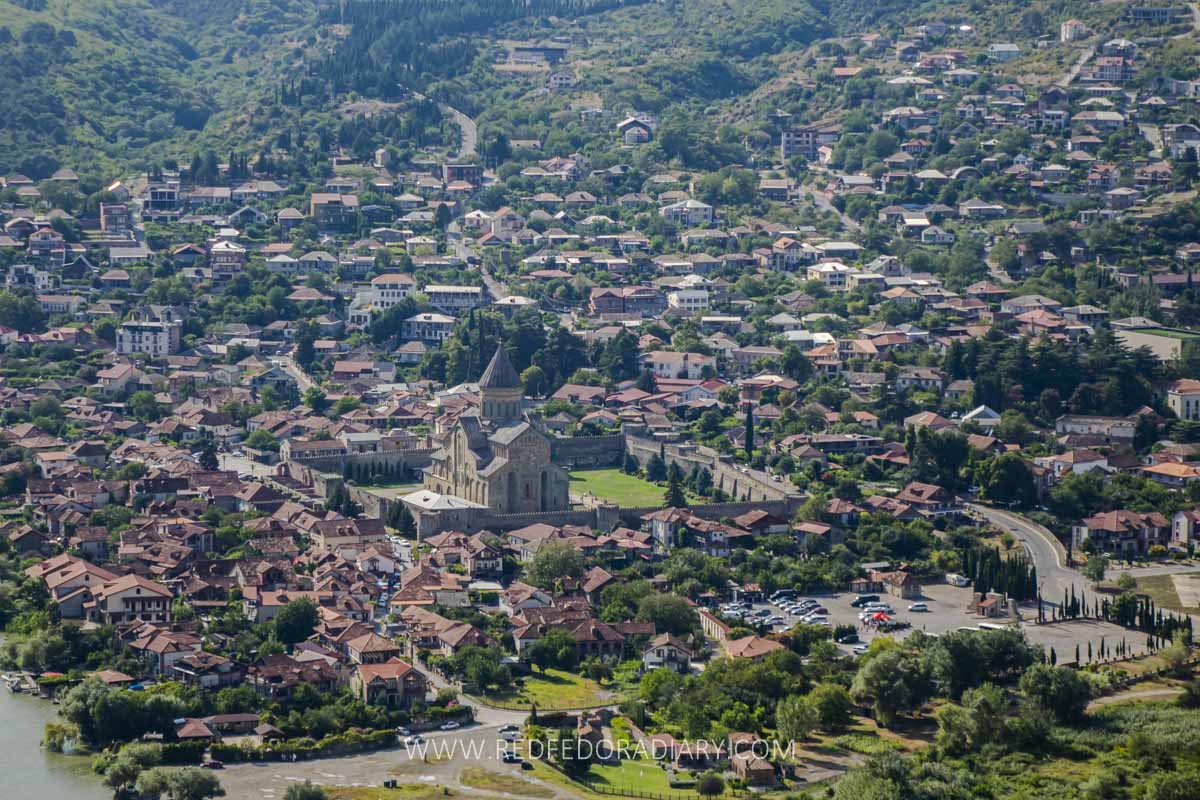
In 337, Iberia became one of the first kingdoms in the world to adopt Christianity as a state religion, and Mtskheta has remained the headquarters of the Georgian Orthodox Church ever since.
The town’s religious role is reflected in its monuments. The earliest Christian church built here was a small wooden structure that later evolved into the Svetitskhoveli Cathedral, one of the most important religious buildings in the country. Together with the Jvari and Samtavro monasteries, it is today part of the UNESCO-listed Historical Monuments of Mtskheta, which was inscribed in 1994.
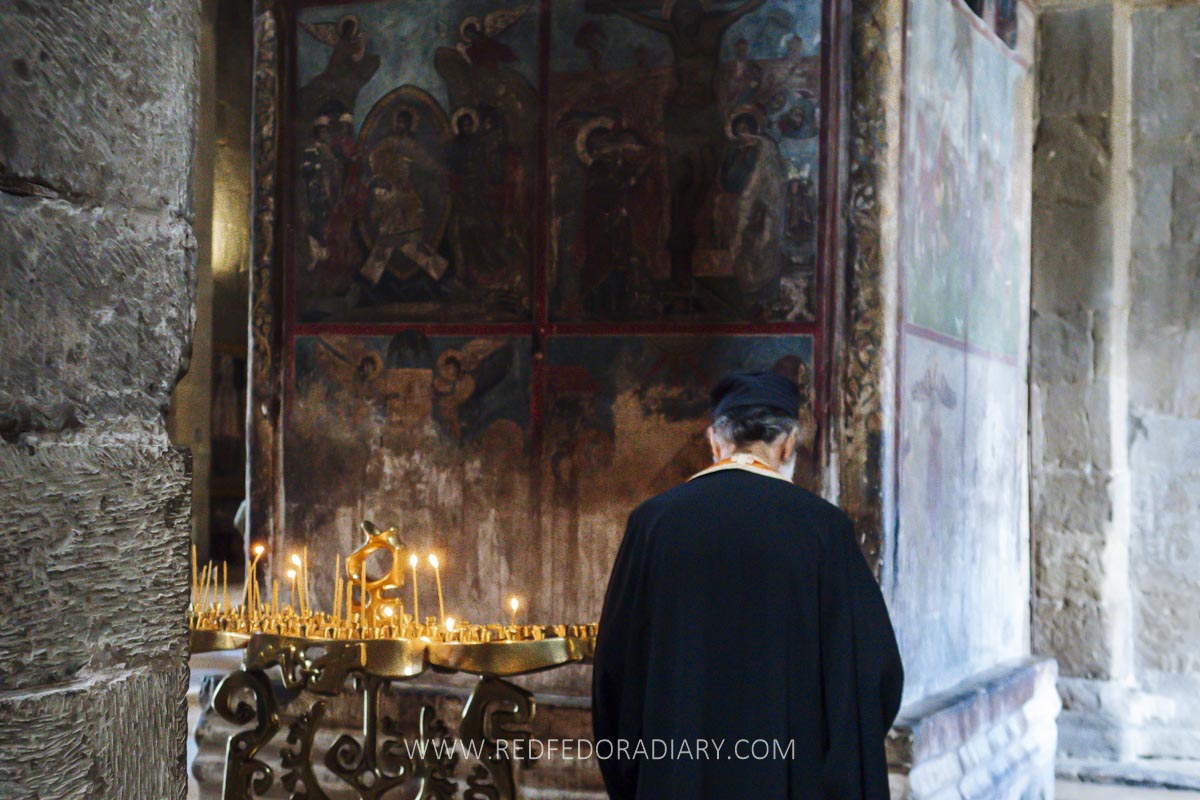
Although its political importance declined once the capital moved to Tbilisi in the 6th century, Mtskheta remained a key ceremonial city—serving as the coronation and burial place for Georgian kings until the 19th century.
Centuries of invasions and destruction reduced it to a small village by the time Georgia was annexed by Russia in 1801, but it revived during industrialization and has since grown into the small yet vibrant town you see today.
16 things to do in Mtskheta
Step inside Svetitskhoveli Cathedral, Mtskheta’s most important landmark
No visit to Mtskheta is complete without stepping inside the Svetitskhoveli Cathedral, the country’s second-largest church (after the Holy Trinity Cathedral in Tbilisi) and one of Georgia’s most sacred sites. Its name, “Svetitskhoveli,” translates as “Cathedral of the Living Pillar.”
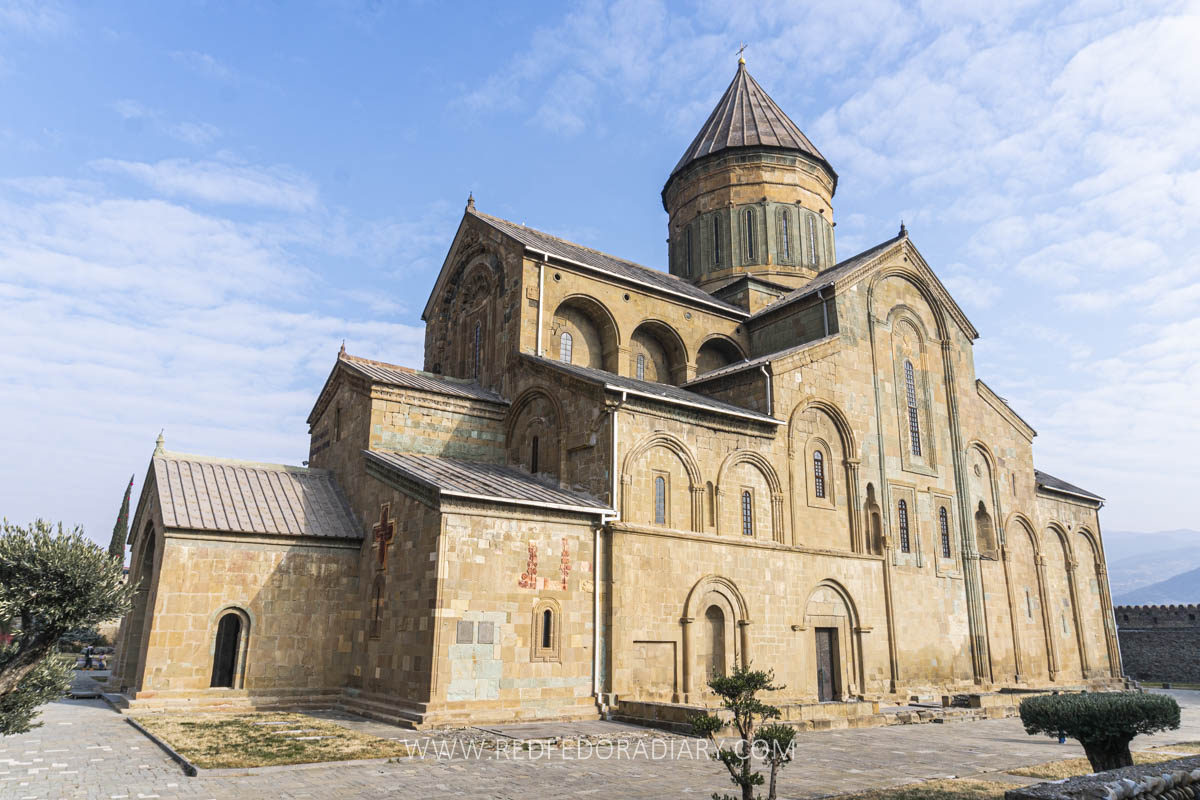
The current stone structure, a masterpiece of the Early and High Middle Ages, was built between 1010 and 1029 by the architect Arsukisdze, though the site’s history stretches back to the 4th century. Its 11th-century stone carvings and decorations still stand as some of the finest examples of Georgian medieval architecture.
Svetitskhoveli is built in the classic cross-dome style, a design characterized by a central dome that spans all four sides, which became the defining feature of Georgian church architecture and dominated after the unification of Georgia under King Bagrat III.
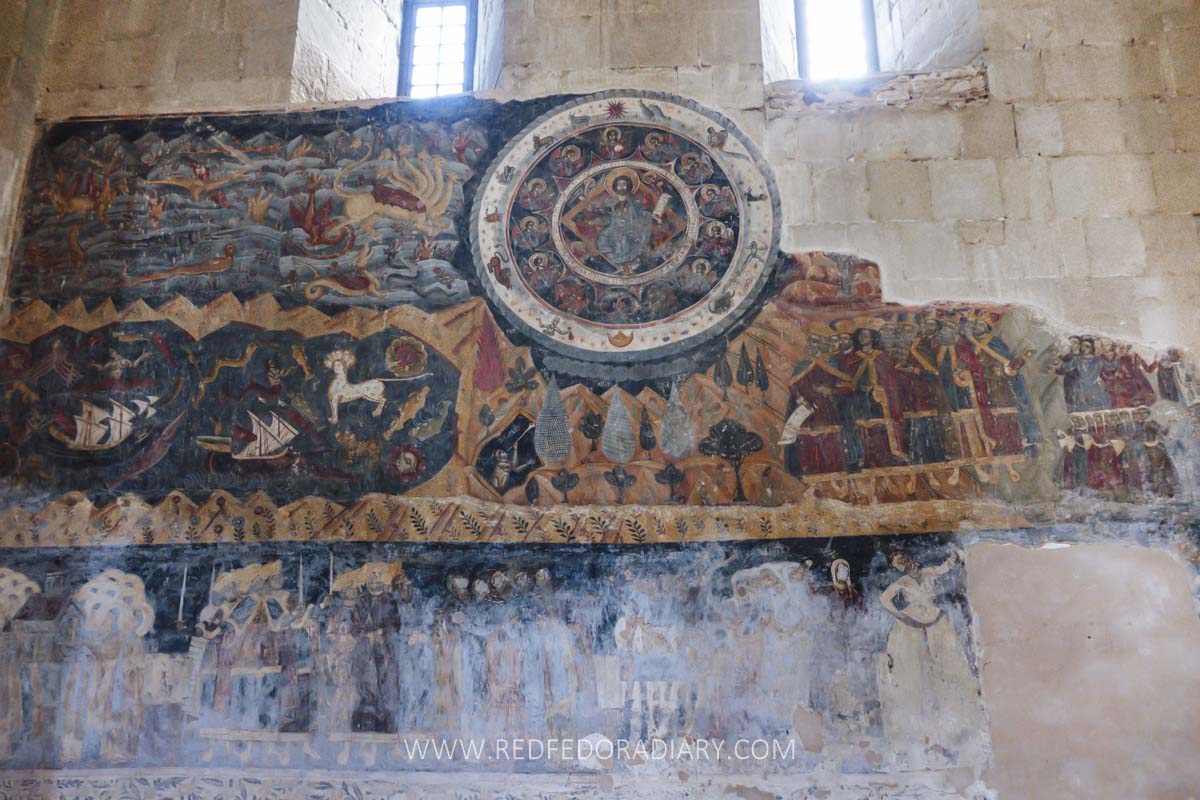
Inside, Svetitskhoveli once dazzled with frescoes that covered the entire walls. Sadly, many of these were destroyed in the 1830s when Russian authorities decided to whitewash the walls to prepare for Emperor Nicholas I’s visit. Ironically, the Tsar never even came, but the damage was done.
Today, a few restored frescoes survive, including a remarkable 13th-century image of the Beast of the Apocalypse and depictions of the Zodiac signs.
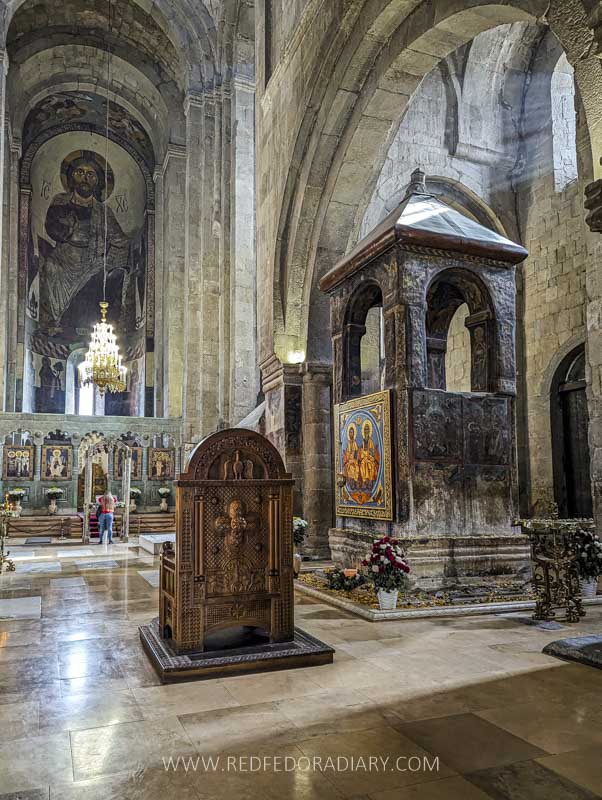
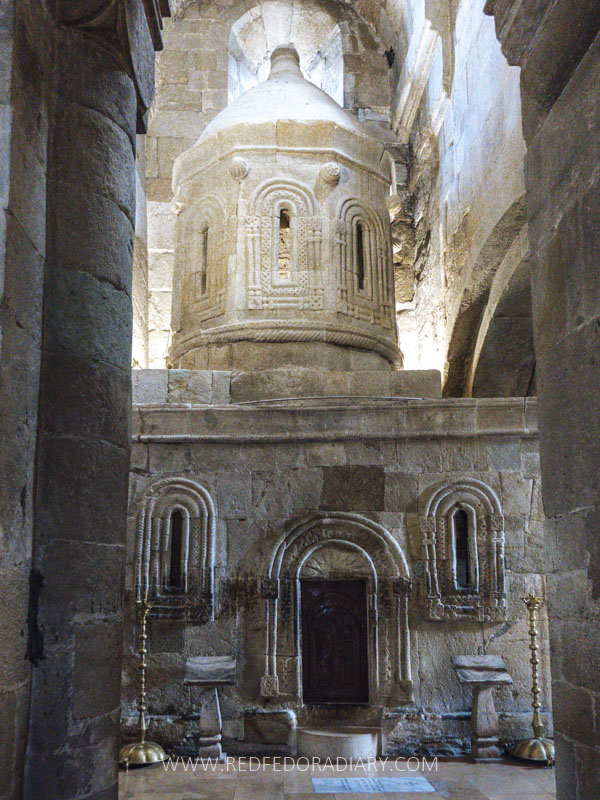
The walls are lined with Orthodox icons, though most are modern copies, with the originals preserved in Georgian museums. At the altar, a large image of Christ painted by a Russian artist in the 19th century dominates the space, while other icons date mainly from the 20th century.
The cathedral was the coronation site of Georgian kings and their final resting place. Inside, you can still see several royal tombs, including King Vakhtang Gorgasali, King Erekle II, and the last king of Georgia, George XII.
- Opening hours: daily from 8 am
Explore Samtavro Monastery with its royal tombs
Located in the northwestern part of Mtskheta’s old town, Samtavro Monastery is another UNESCO-listed monument that combines the Samtavro Transfiguration Church with the Nunnery of St. Nino.
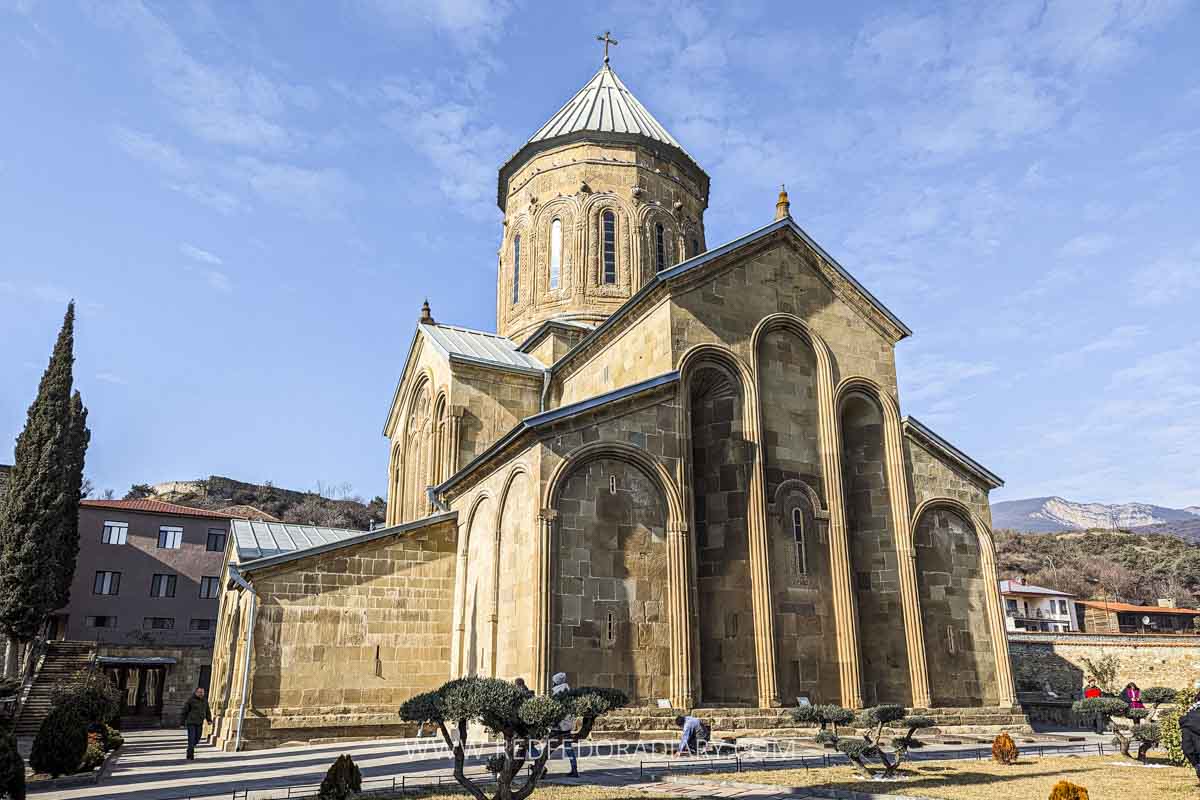
The name Samtavro translates as “the ruler’s place”, built in the 4th century under King Mirian III, Georgia’s first Christian king, after Saint Nino converted the kingdom to Christianity. Both Mirian and his wife, Queen Nana, are buried here.
The current church dates back to the 11th century, with a reconstruction shortly after the construction of Svetitskhoveli Cathedral. Its cross-in-square design, with a central dome, follows the hallmarks of medieval Georgian architecture, although the dome was later rebuilt after a devastating earthquake in 1283.
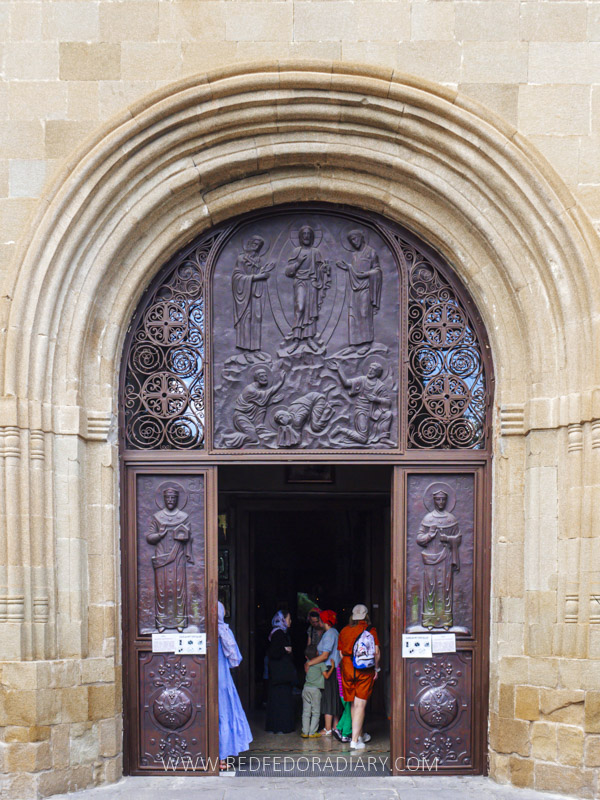
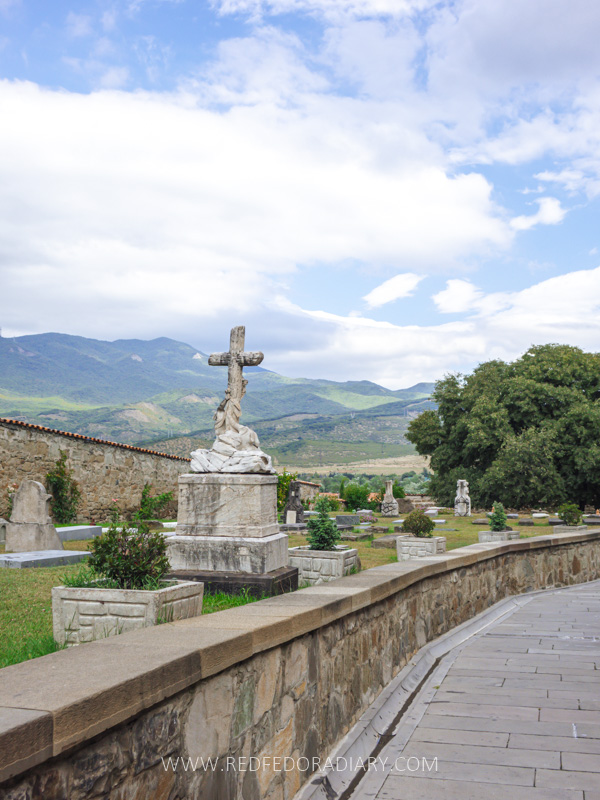
Frescoes from the early days did not survive, but the feature includes 16th– and 17th–century paintings and a later stone iconostasis.
Samtavro is also closely associated with Saint Gabriel, one of Georgia’s most beloved modern monks, whose grave in the courtyard attracts many pilgrims.
- Opening hours: daily from 9 am to 7 pm
Visit Jvari Monastery of Mtskheta, built on the site of St. Nino’s cross
Perched high on a rocky mountaintop at the confluence of the Mtkvari and Aragvi rivers, Jvari Monastery is one of the most iconic sights in Georgia, offering the best panoramic views of the ancient capital.
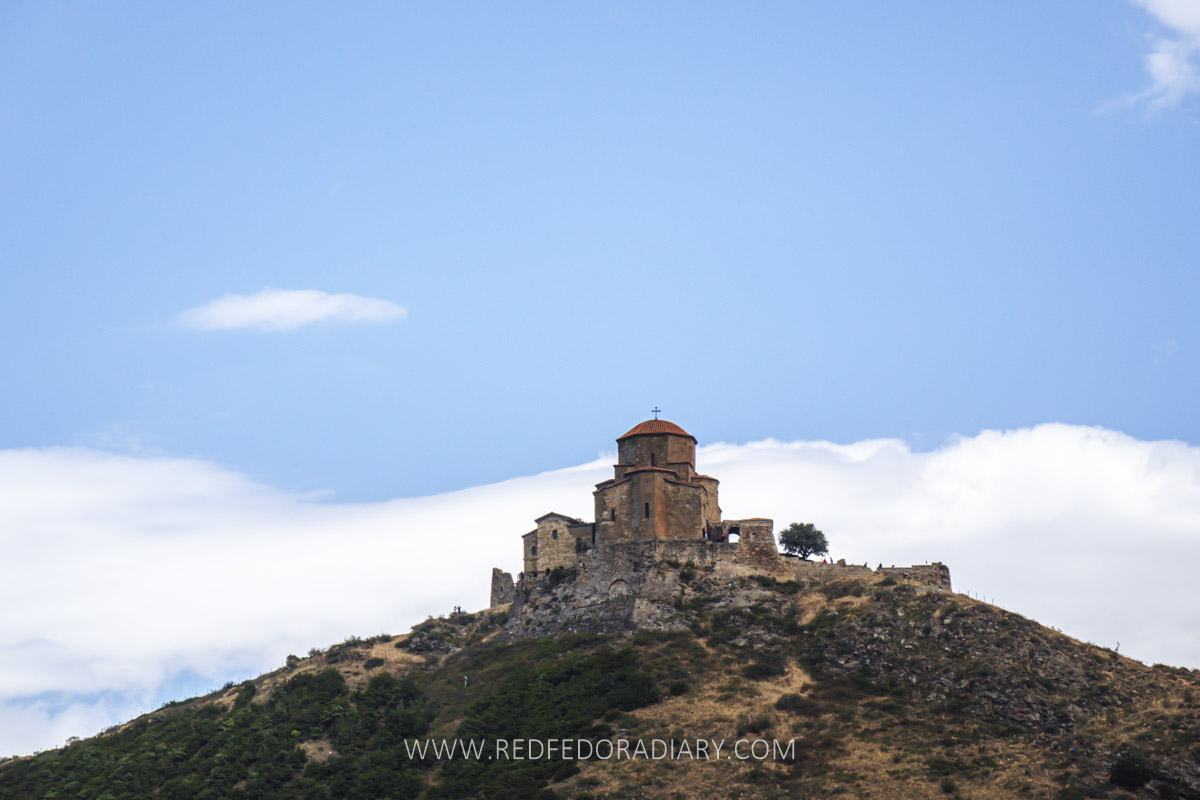
Built in the 6th century, its name means “cross”, a reference to the wooden cross that Saint Nino erected here after converting King Mirian III and his kingdom to Christianity.
Pilgrims soon flocked to the site, and the small chapel that first stood here was replaced with the larger “Great Church of Jvari” around 590–605.
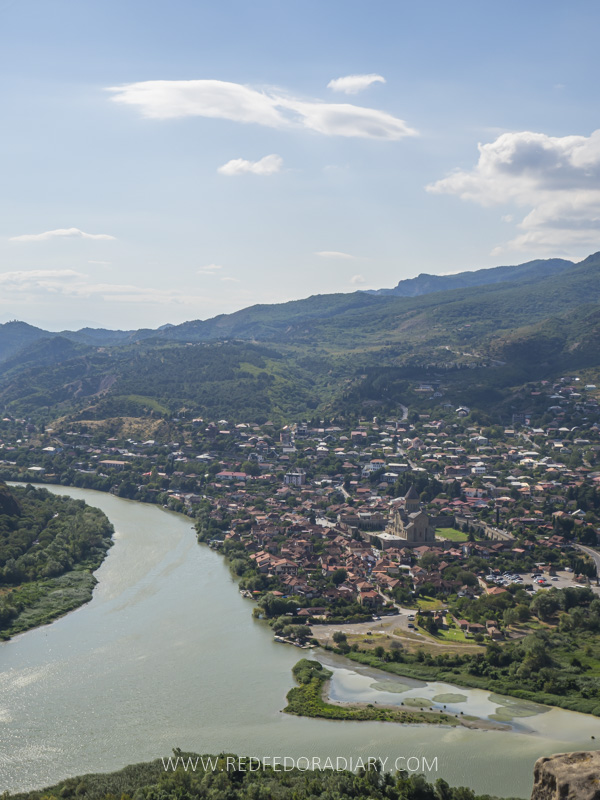
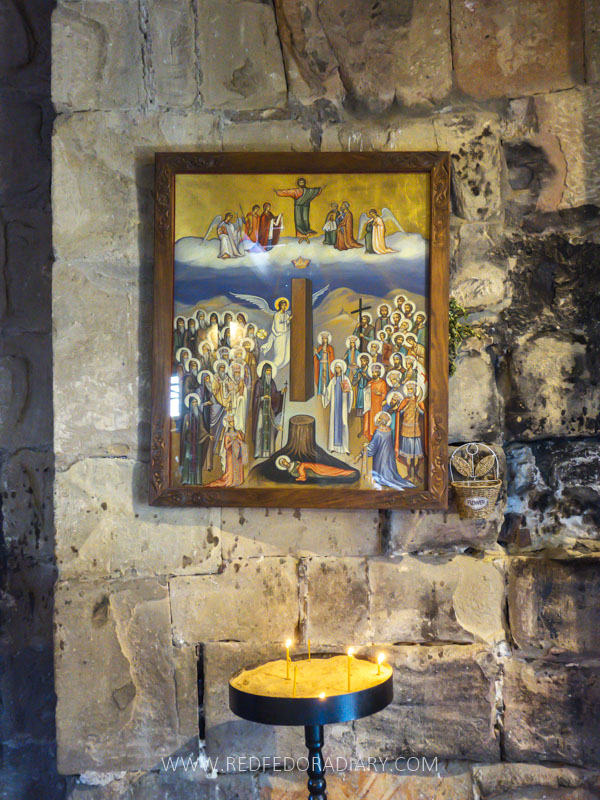
Jvari is considered a masterpiece of Early Medieval Georgian architecture and gave its name to the so-called “Jvari type” of church design, which went on to influence many other religious buildings in Georgia and Armenia.
Remarkably, the structure has survived almost unchanged since its construction. Inside, you can still see the postament of Saint Nino’s cross, now supporting a newer wooden cross.
- Practical info for visiting Jvari – The church itself usually opens around 10 am, although the grounds are accessible at any time. Since the interior is quite plain, many people come mainly for the views, which are stunning at any hour.
- How to get there: From the center of Mtskheta, you can grab a taxi up to Jvari for about 25-30 GEL round-trip, with drivers often waiting near the Tourism Information Office.
Stroll the streets of Mtskheta old town
The streets around Svetitskhoveli Cathedral are pedestrian-friendly and filled with stalls, small shops, and cafes. Here, you’ll find churchkhela, a traditional Georgian sweet snack, hanging in rows, spice stands, fresh juices in the summer, and hot mulled wine in the winter.
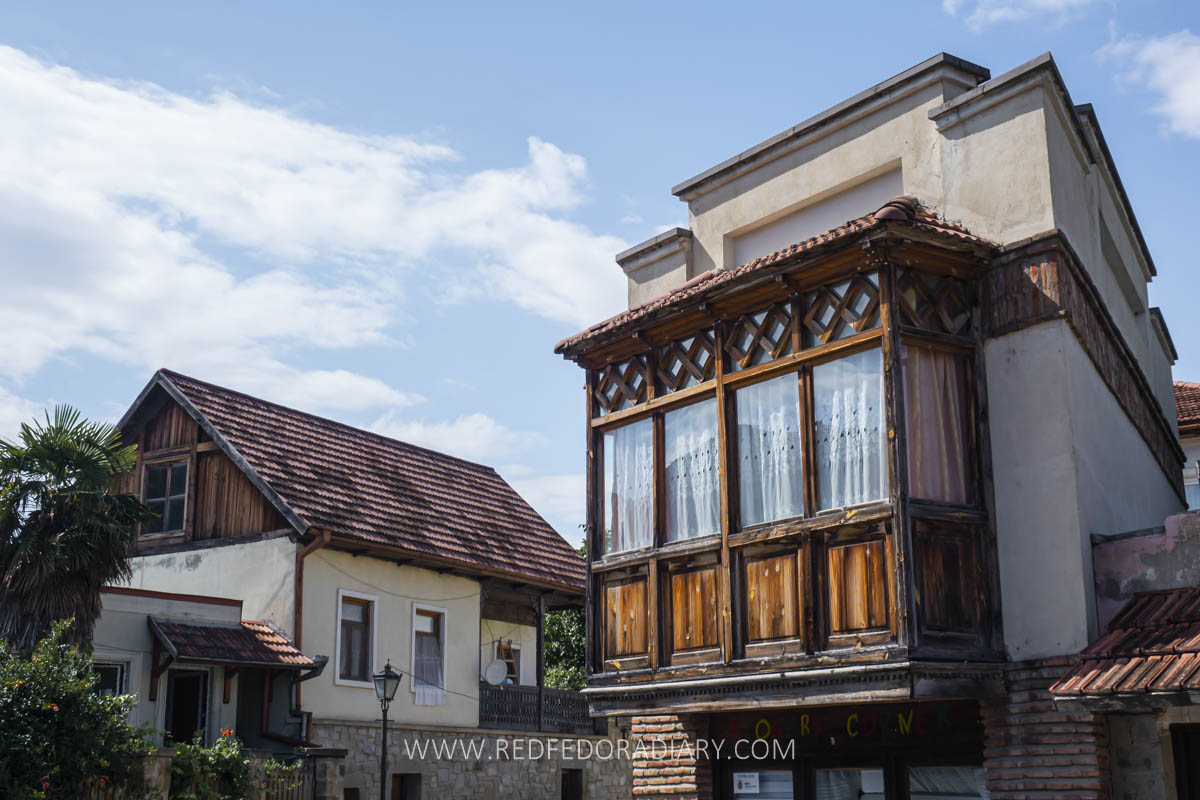
The area is geared towards tourists, and prices tend to be higher than elsewhere. The stalls are also filled with mostly mass-produced souvenirs that I don’t recommend buying here. Instead, check out my detailed Georgian souvenir guide, which includes an extensive list of souvenir shops in Tbilisi, along with a map.
Beyond the market-y vibe, the real charm lies in the architecture of old houses in its backstreets, with carved wooden balconies that showcase the city’s character beyond its churches.
Marvel at the Tree of Life mosaic
On the facade of Mtskheta’s former cinema building (named Karibche and meaning “gate”), you’ll spot a beautiful Soviet-era mosaic known as the Tree of Life.
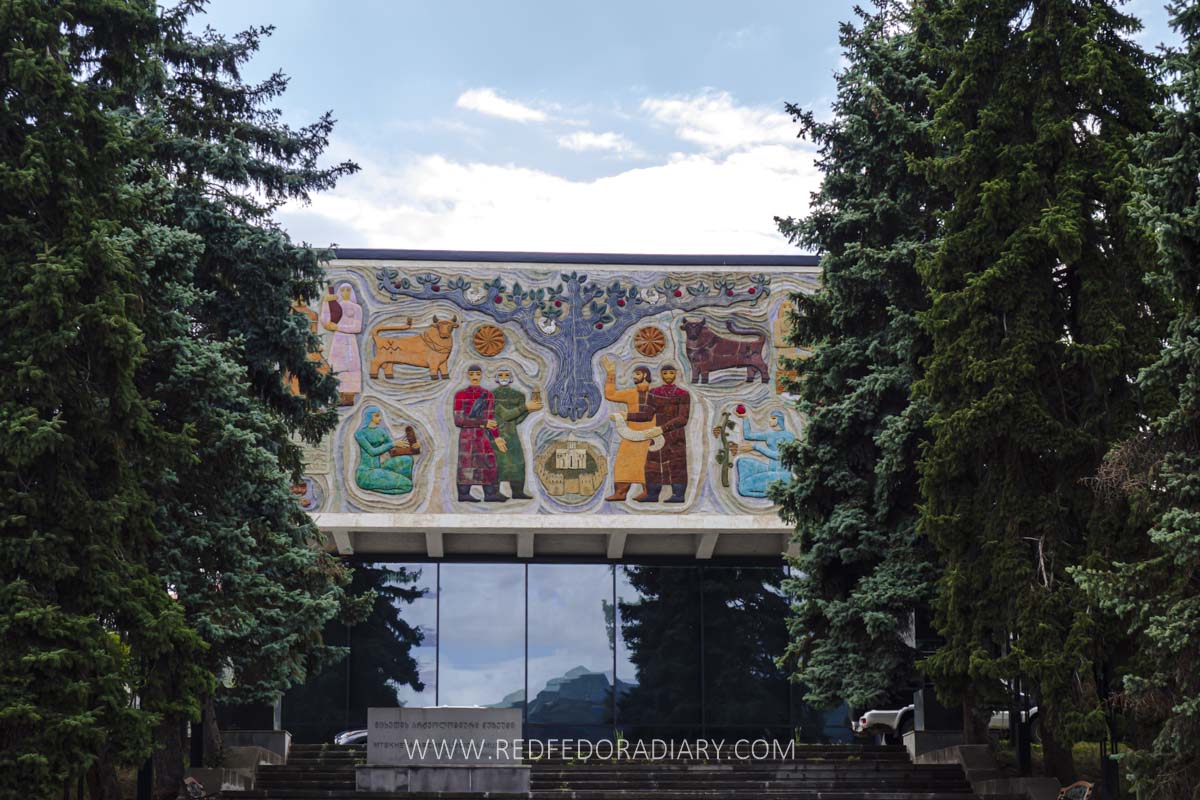
Installed in 1973, it weaves together motifs from Georgian culture, with a small image of Svetitskhoveli Cathedral at its center.
The building itself has been undergoing renovation for many years now and is slated to become the Mtskheta Museum, but the mosaic remains an eye-catching detail worth stopping for.
It’s one of the few examples of monumental Soviet artwork preserved in Mtskheta.
Try the famous Mtskheta pie
One of the town’s culinary icons is the Mtskheta pie, a deep-fried pastry filled with minced beef and pork, rice, and spices such as black pepper and utsko suneli (blue fenugreek). The result is a golden, fluffy pie that’s crispy on the outside and savory inside.
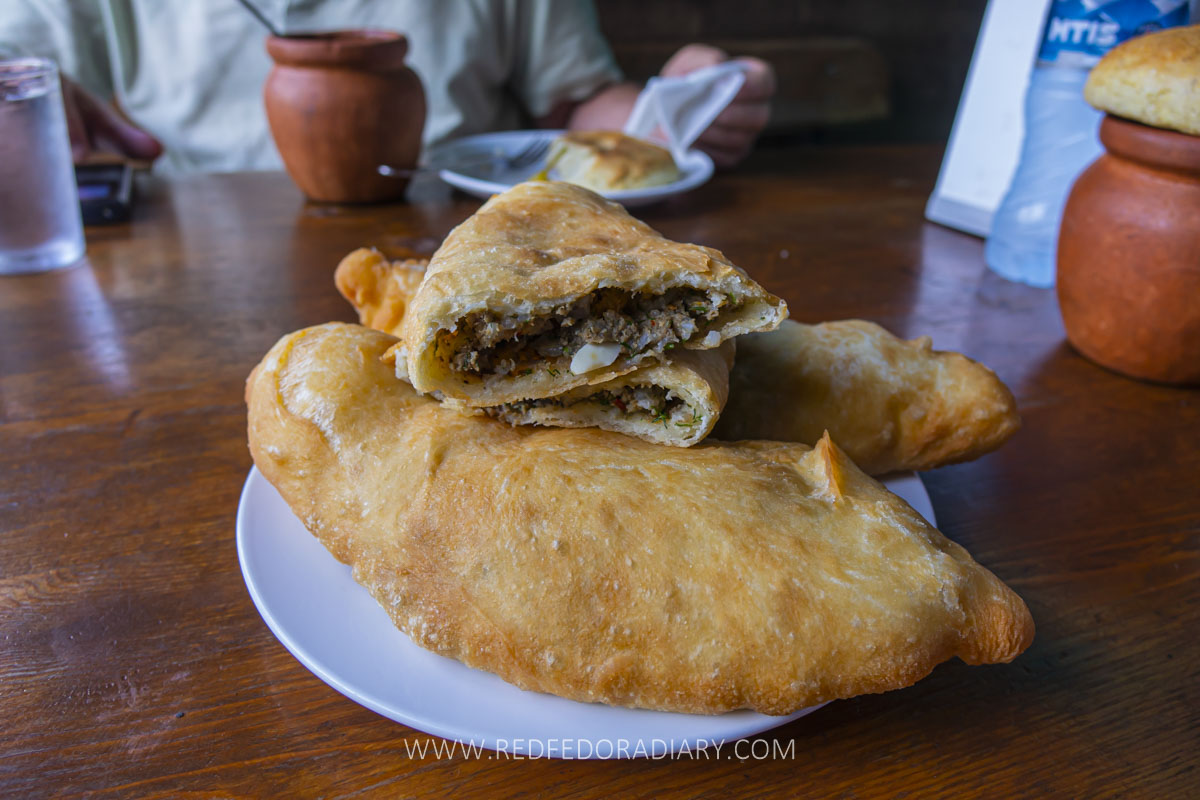
The recipe is believed to date back to the late 18th century, when the Gegechkori family in Mtskheta began making veal pies for family and neighbors, but got so popular that they eventually sold them at a small booth by the railway station.
Passengers stopping briefly in town soon spread the word, and what started as a family dish grew into one of the region’s best-loved street foods.
Today, you can still try the traditional Mtskheta pie at places like Salobie, a well-known restaurant just outside town (see the next section).
Have lunch or dinner at Salobie
One of the things to do in Mtskheta is to eat at the iconic Mtskhetis Salobie (the bean house of Mtskheta), because no trip to the city is complete without a stop here. Open since 1967, it’s one of the oldest and most popular eateries in Georgia.
The restaurant was initially created to serve travelers along the Mtskheta tourist route, offering them a place to rest and eat after a long day of sightseeing before heading back to Tbilisi.
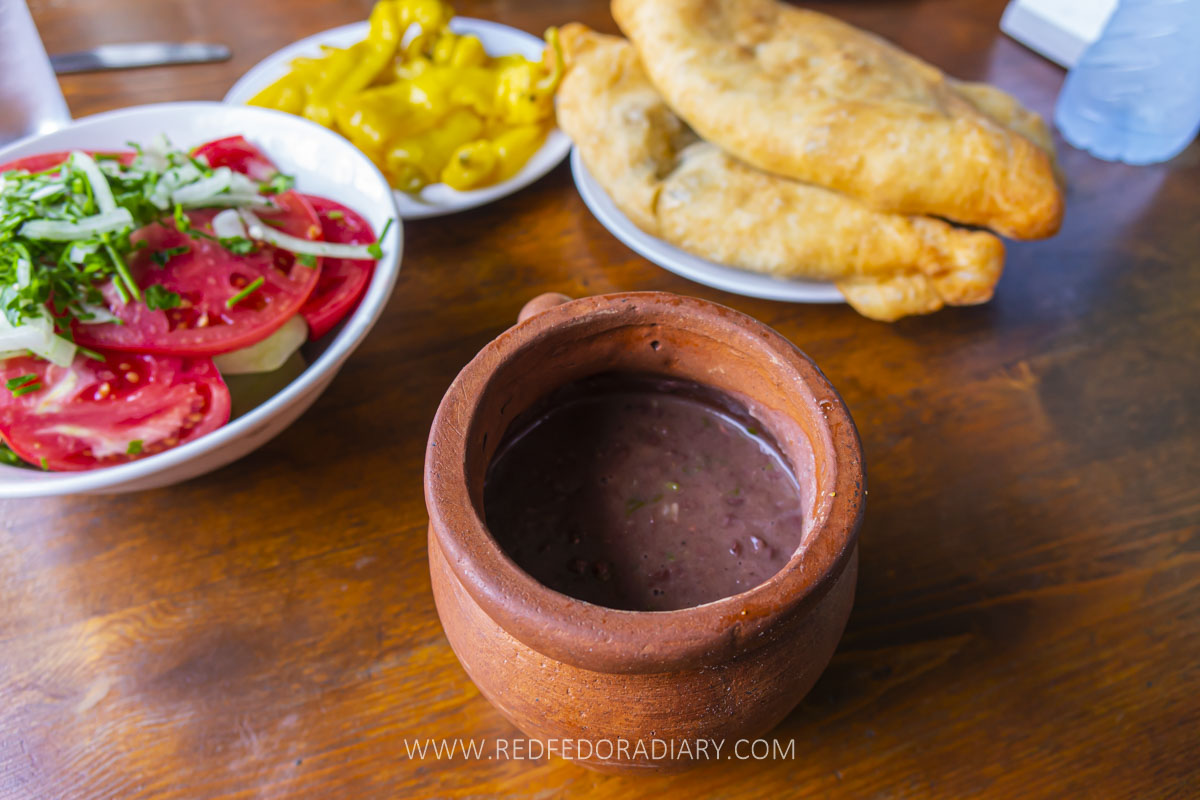
The menu is short and centered on Georgian staples: khachapuri, lobiani, khinkali, mtsvadi (BBQ), kebabs, and salads.
But the star of the show is the lobio — a black bean vegetarian stew served in clay pots. To eat it like a local, pair it with mchadi (cornbread) and a plate of assorted pickles.
Salobie is a simple, no-frills place, but that’s precisely what makes it special. However, if you are looking for more eateries within the city itself, I provide a few options below in the section titled “Mtskheta cafes and restaurants.”
Notice the Bridge of Pompey beneath the Mtkvari
Among Mtskheta’s lesser-known landmarks are the remnants of the so-called Bridge of Pompey, believed to have been built by Roman legionnaires during Pompey the Great’s campaign in the 1st century BC. Local sources also refer to it as the Magi Bridge.
The remains usually lie hidden under the waters of the Mtkvari River, but when water levels drop, you can spot traces of the ancient structure if you are lucky to be passing by at the right time.
See Samtavro necropolis
North of the city lies the Samtavro necropolis, an archaeological site that reveals Mtskheta’s role as one of the oldest continuously inhabited places in Georgia.
The burial ground dates back to the third millennium BC and was in use until the 10th century, making it one of the most important cemeteries ever excavated in the Caucasus.
Archaeologists have uncovered more than 3,000 graves here, ranging from simple stone tombs to elaborate sarcophagi.
Finds from the site include pottery with geometric patterns, bronze and iron tools, gold jewelry, pearls, and even zoomorphic bronze figurines — a peek into the lives, beliefs, and artistry of Georgia’s earliest inhabitants.
Although it’s not as visually striking as the monasteries or other Mtskheta landmarks, the Samtavro necropolis connects the city to the Bronze and Iron Age communities that shaped the foundations of Georgian culture.
Walk the grounds of Bebris Tsikhe fortress
On the northern edge of Mtskheta, guarding the Aragvi River valley, you’ll find Bebris Tsikhe (translated as “fortress of an old man”), one of Georgia’s oldest fortresses. In medieval times, its primary role was to defend both Mtskheta and Tbilisi from invasions coming from the Greater Caucasus.
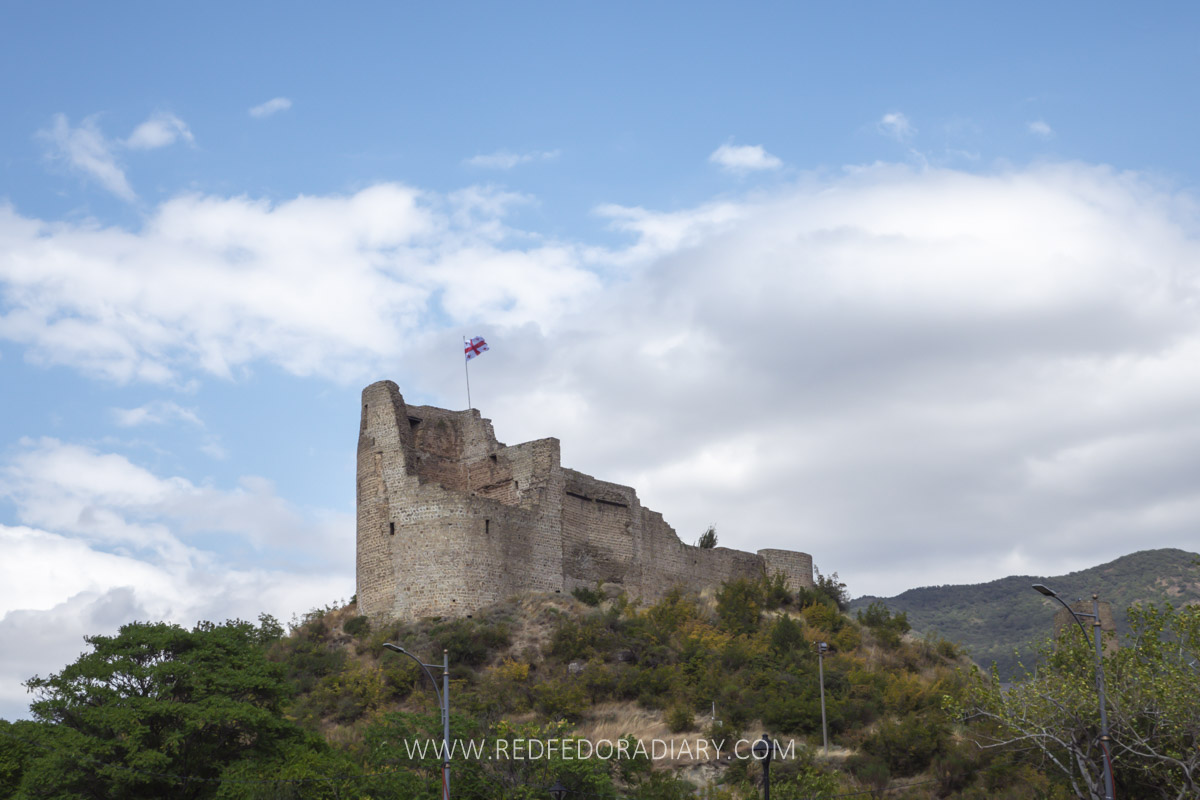
The fortress, recognized as a National Cultural Monument of Georgia since 2004, blends seamlessly into the rocky hillside, almost as if it were an extension of the mountain itself. Its walls are more than two meters thick, enclosing a triangular citadel with three towers.
The largest, on the southwest corner, also functioned as a dungeon with multiple levels and embrasures for archers.
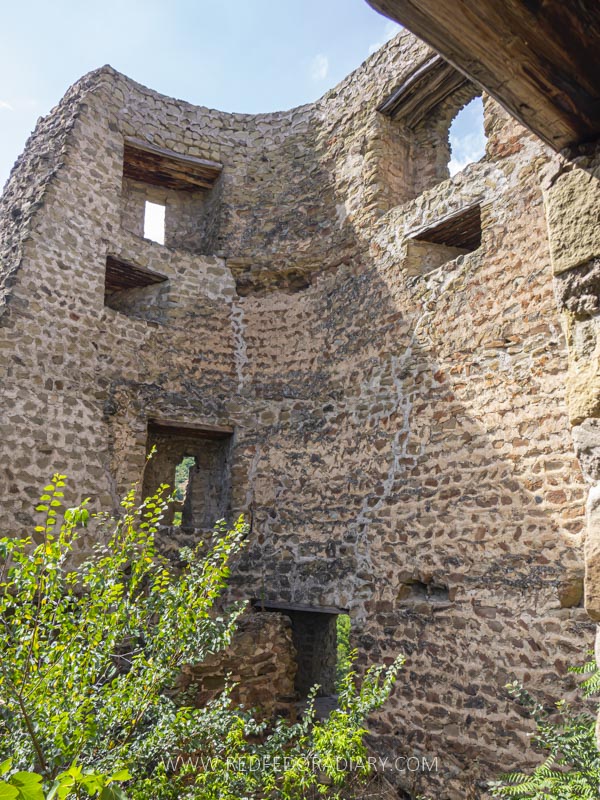
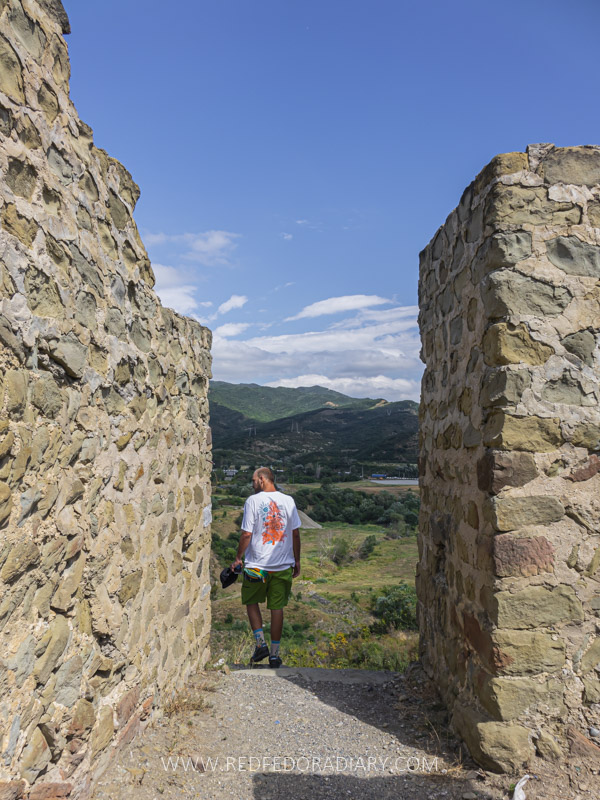
Although Bebris Tsikhe is less visited than Mtskheta’s churches and parts of the lower courtyard are in ruins today, it presents gorgeous views of the river valley and the ancient city.
Attend Svetitskhovloba in October
Every year on October 14, Mtskheta hosts Svetitskhovloba — a religious and cultural holiday dedicated to Svetitskhoveli Cathedral and the city itself. Also known as Mtskhetoba, the day is a public holiday, and the celebration attracts pilgrims and visitors from across Georgia and beyond.
The day is marked with festive church services, processions, and public gatherings around Mtskheta. Alongside honoring the cathedral, the holiday also commemorates King Mirian and Queen Nana, Georgia’s first Christian monarchs. For locals, Svetitskhovloba is as much about faith as it is about celebrating the town’s history and community spirit.
Visiting Mtskheta during this time means streets fill with worshippers, families, and vendors, and the atmosphere is one of both reverence and festivity.
Other places to see outside Mtskheta
Shio-Mgvime Monastery
Hidden in a limestone canyon about 9 km from Mtskheta, the Shio-Mgvime Monastery (literally “the cave of Shio”) is one of the most atmospheric monastic complexes in Georgia, featuring fascinating frescoes inside.
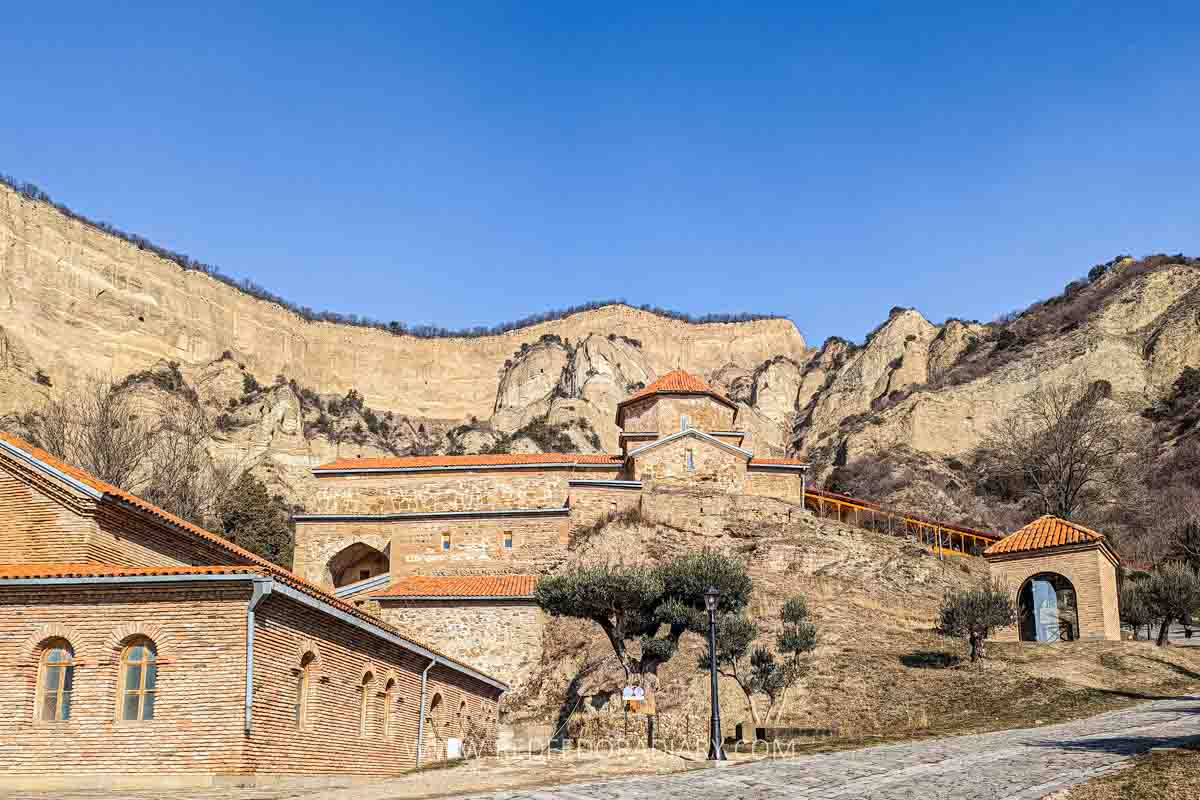
According to tradition, it was founded in the 6th century by St. Shio, one of the Thirteen Assyrian Fathers, who spent his final years as a hermit in a cave here. The caves carved by monks are still visible around the site today.
The earliest church, built in the 560s, is dedicated to St. John the Baptist and represents one of Georgia’s oldest surviving cruciform churches. Later additions include the 12th-century Upper Church, a refectory, and a small chapel decorated with medieval frescoes.
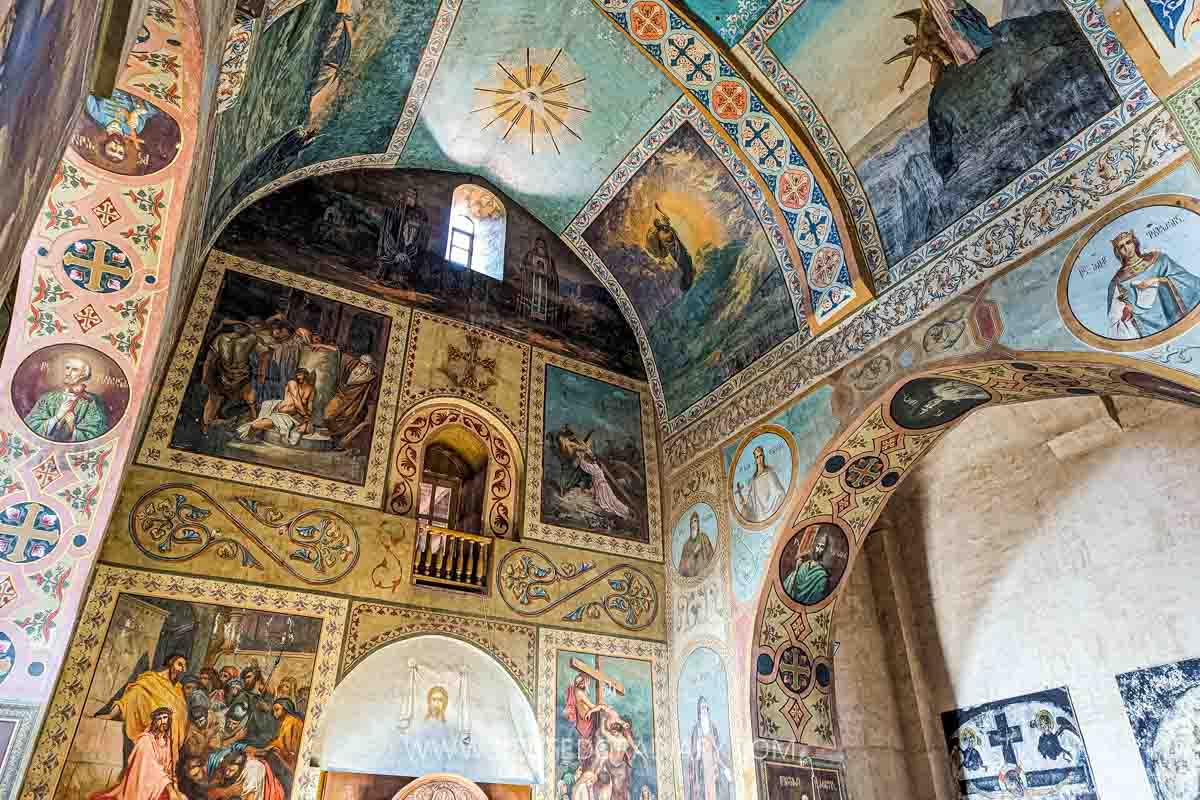
At its peak, Shio-Mgvime housed up to 2,000 monks and served as a significant cultural and religious center under the patronage of Georgian kings, including David the Builder.
Over the centuries, the monastery endured repeated invasions and devastation — from the Persians and Ottomans to the Bolsheviks’ closure. Today, it remains an active monastery and a popular place of pilgrimage.
Dzalisi archaeological site and ancient Roman mosaics
Approximately 20 km northwest of Mtskheta lies Dzalisi, once a principal town of the Kingdom of Iberia that today is home to the remains of an ancient settlement, including palaces, hypocaust baths, a swimming pool, soldier barracks, and an advanced water supply system.
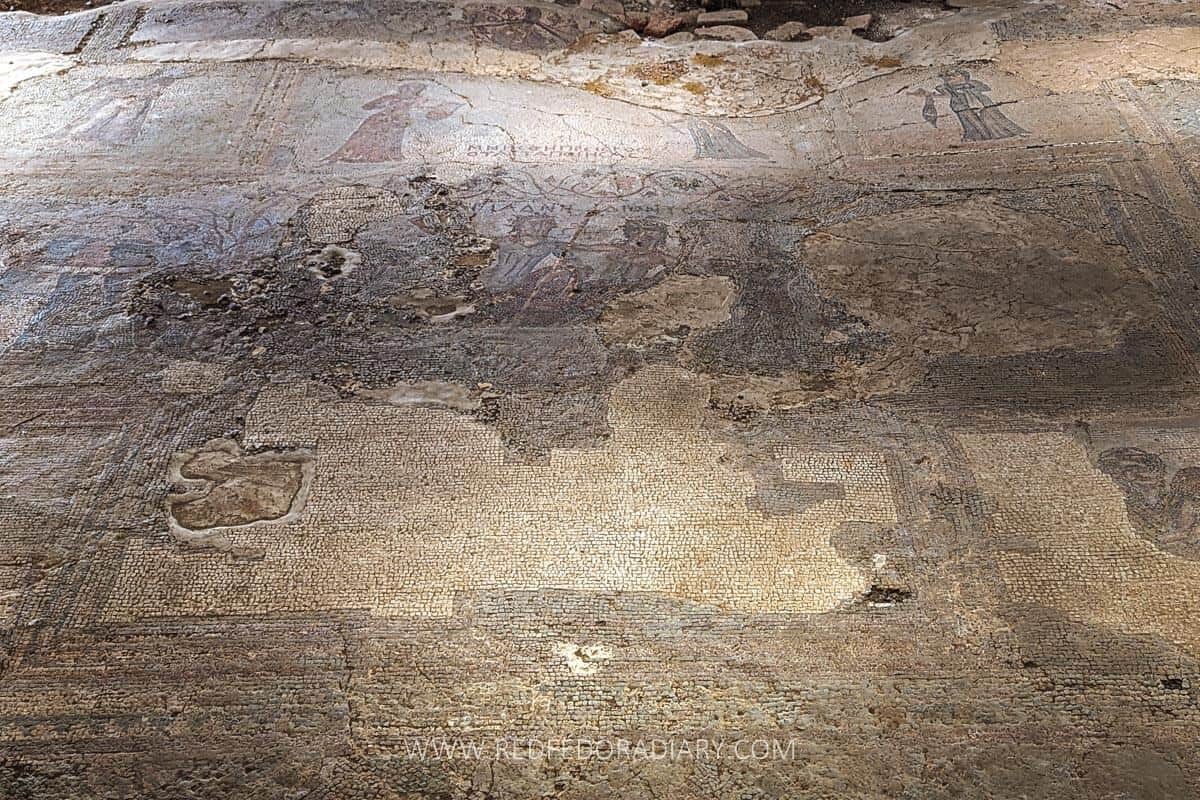
The site’s highlight is a set of floor mosaics dating to around the 3rd–4th century AD. Depicting the banquet of Ariadne and Dionysus, these mosaics are among the oldest ever discovered in the Caucasus, rivaling those at Pityus in present-day Abkhazia, a breakaway region of Georgia.
While the ruins themselves are scattered and partially preserved, Dzalisi is one of those places I wish attracted more attention than it actually does; after all, it is an important cultural and historical sight that has also been mentioned by the Roman geographer Ptolemy in the 2nd century AD.
Château Mukhrani
A short drive from Mtskheta and/or Dzalisi brings you to Château Mukhrani, once the grand 19th-century estate of Prince Ivane Mukhranbatoni and today a working winery with a restaurant, tasting rooms, and guided tours.
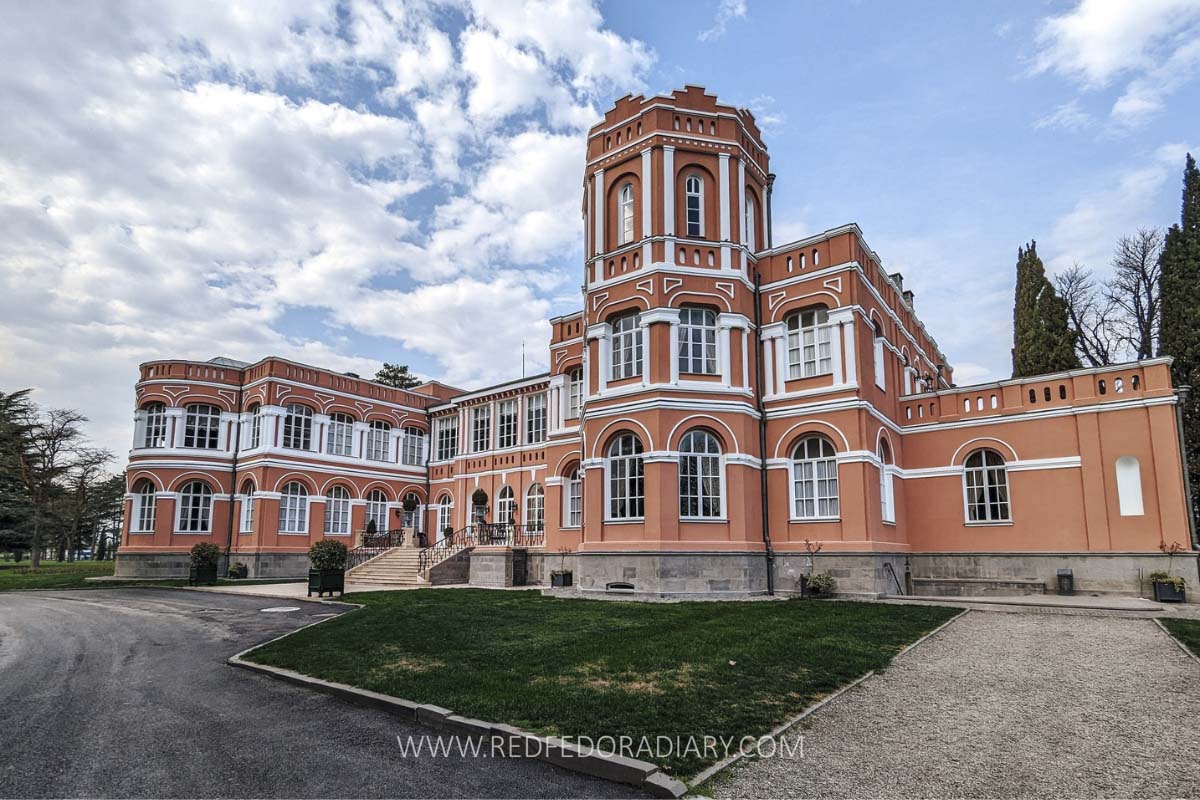
Built between 1871 and 1882, the château was modeled after European palaces, with opulent halls, gilded furniture, a grand piano, and carefully curated gardens designed by a French gardener. It quickly became a cultural hub, attracting Georgia’s elite and foreign visitors alike of that time.
Today, the estate carries on that legacy with wine tastings, cellar tours, and meals at L’Orangerie, a bright, glass-walled restaurant overlooking the vineyards. You can visit the premises without booking a tour or a wine tasting or have a drink/lunch at its greenhouse-like restaurant.
Soviet mosaic in Dzegvi village
About 20 minutes from Mtskheta, in the small village of Dzegvi, you can spot a partly preserved Soviet-era mosaic on the facade of the former Gas Administration building. Unfortunately, neither its author nor the exact date of creation is known.
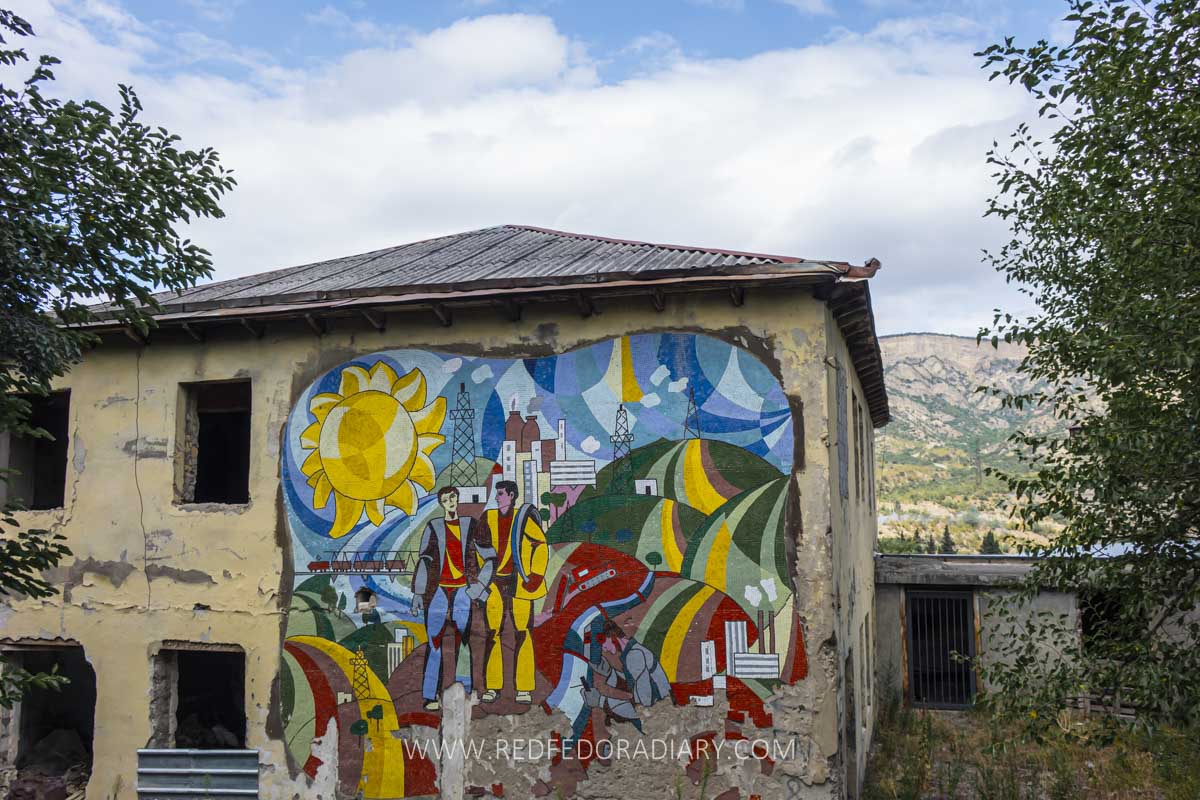
The mosaic carries an industrial theme, with men as the central figures surrounded by scenes of rolling fields, residential houses, and factories at work in the background.
Sadly, like many mosaics in Georgia, several sections are missing — yet enough remains to capture the spirit of an era when industry and collective progress were dominant artistic motifs.
Didgori Battle Monument
If you’re up for venturing a little further from Mtskheta, about a 45-minute drive into the Kvemo Kartli region, stands the Didgori Battle Monument — one of my favorite monuments in Georgia.

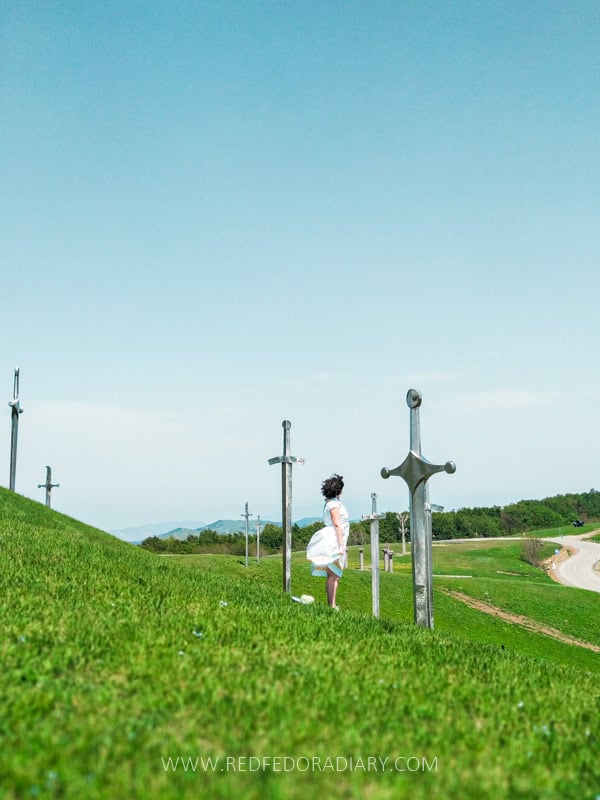
The stunning memorial complex commemorates the Battle of Didgori in 1121, when King David the Builder led the Georgian army to a legendary victory over the Seljuk Turks. Historians call it “The Miraculous Victory”, as it marked the beginning of Georgia’s golden age.
The monument itself spans a wide open area, featuring striking and towering swords planted in the ground, ceremonial pillars, and bells, among other elements.
Things to do in Mtskheta map
For a more comfortable way of exploring the city, here is the Google Maps list of what to do in Mtskheta to save and use. You would not need the data to access the spots if you download the area for offline use.
Tips for planning a Mtskheta day trip from Tbilisi
Best time to visit Mtskheta
You can travel to Mtskheta any time of year — the churches and monasteries are open year-round, including on Christmas and Easter.
Obviously, I haven’t counted the number of times I’ve been to Mtskheta, but I can confidently say it has been in every season. Therefore, the most beautiful time to visit Mtskheta is either late spring, early summer, or autumn for picturesque landscapes and scenery.
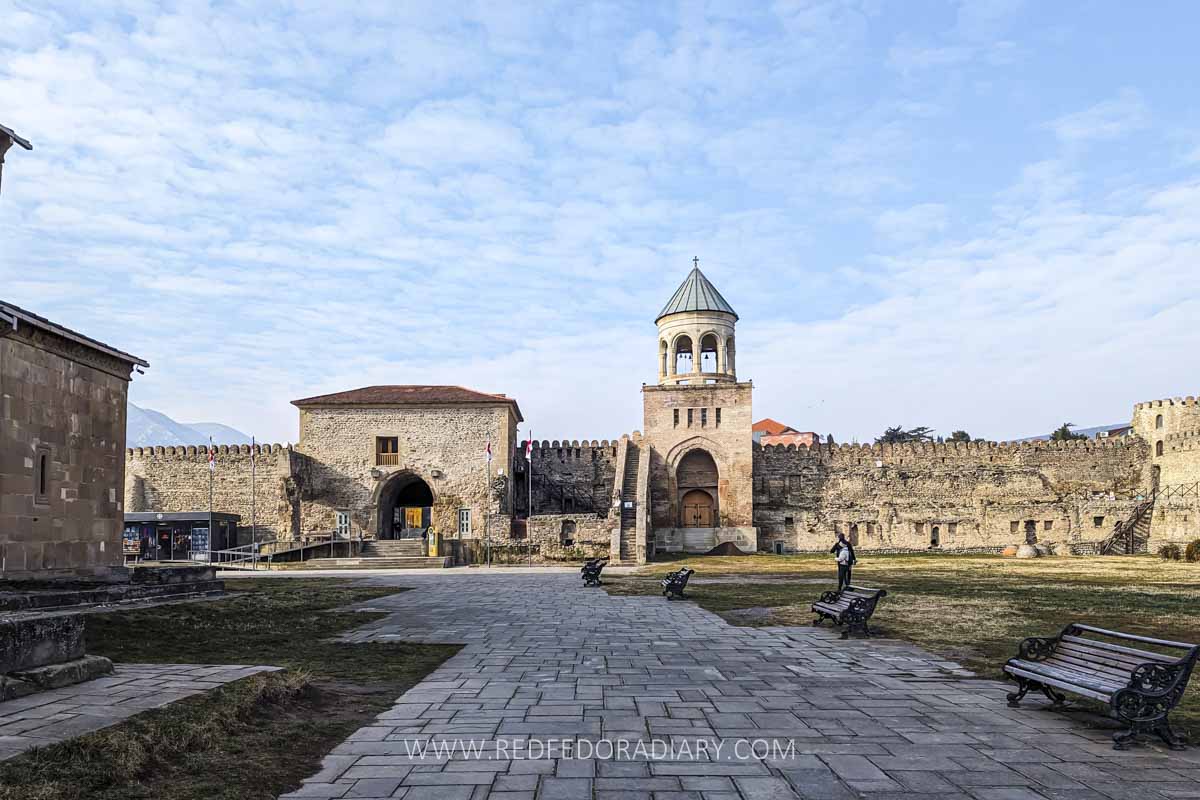
As mentioned above, October 14 marks Svetitskhovloba (Mtskhetoba), the annual celebration of the cathedral and the city itself. On this day, pilgrims gather for services, and the town comes alive with ceremonies, music, and food stalls.
Summers can be extremely hot, so be sure to bring water and sun protection if you’re visiting from June to September. Weekends are busier with locals coming from Tbilisi, so transport may be crowded.
My biggest tip is to leave Tbilisi early and arrive in Mtskheta around 9-10 am. This will give you time to enjoy the sights and the city before the big tour buses arrive.
One day in Mtskheta: is it realistic?
For most travelers, spending one day in Mtskheta is realistic to see its main landmarks, whether you are doing it on your own or joining a tour.
Many also combine Mtskheta with Gori, known as Stalin’s birthplace or Uplistsikhe cave town, but in that case, you need to choose what you’d want to see.
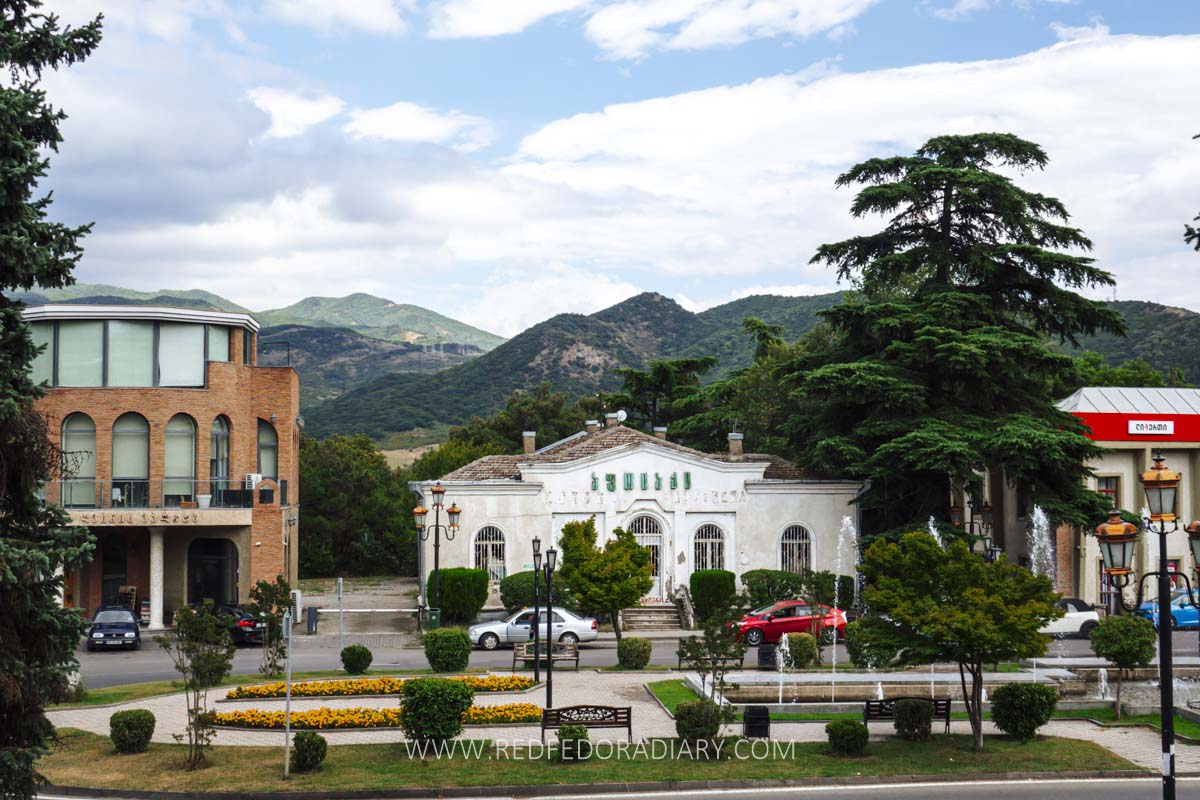
I’d suggest sticking with UNESCO-listed churches and a few sights that are within walking distance of them, and save the remote places for when you have extra time.
If you prefer a slower pace, staying overnight is an option. I’ve listed accommodation suggestions at the end of this post, in case you decide to extend your visit.
Self-guided vs guided visit to Mtskheta
As a local, I have never taken a guided tour of Mtskheta, as we are taught the history more or less at school; however, for a foreigner, it’s a place where having a guide can really change your experience.
Signage is limited, and without context, it’s easy to feel like you’re just hopping between churches.
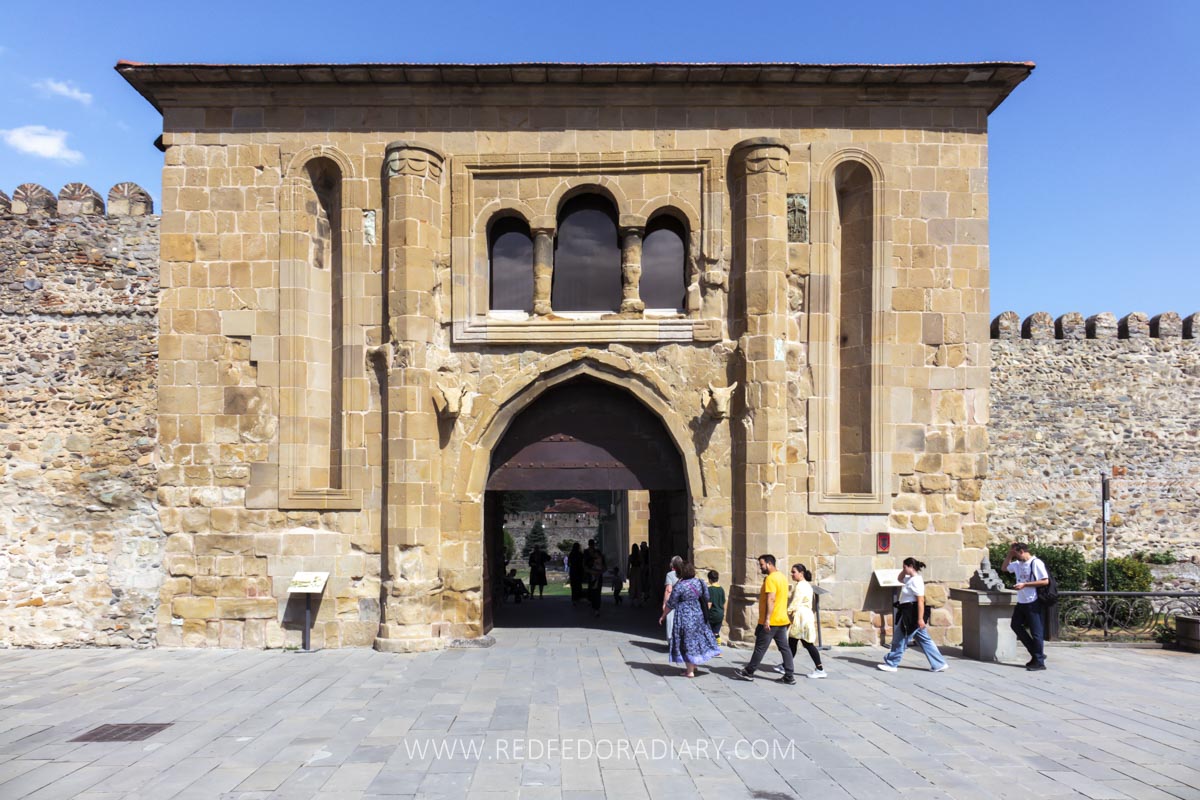
Numerous companies offer tours to Mtskheta via Viator or GetYourGuide, and most also include visits to Gori and Uplistsikhe, available in both group and private options.
Look for one that starts early in the day and maintains small group sizes. If you’re mainly interested in Svetitskhoveli, guides are also available at the cathedral itself.
How to get from Tbilisi to Mtskheta
The distance from Tbilisi to Mtskheta is approximately 20 km, making it the most popular and convenient day trip from the capital. Whether you prefer a budget-friendly option or something more comfortable, there are several ways to travel from Tbilisi to Mtskheta, depending on your time and preferences.
Join a guided tour
The simplest option is to book a guided day trip. Transport is included, and you’ll also have someone explain the history and stories behind the landmarks.
Tours range from half-day group trips to full-day private excursions that include nearby sights such as Gori or Uplistsikhe. If you want a stress-free experience and context for what you’re seeing, this is the most convenient choice.
Mtskheta tour from Tbilisi to consider:
Day Trip to Mtskheta, Gori, and Uplistsikhe ⭐ 4.9 From 30 USD: this full-day trip covers three of Georgia’s cultural highlights in one go. You’ll explore centuries of history with a knowledgeable guide, travel in a comfortable coach, and have time to enjoy the views and atmosphere at each stop. → Check prices & availability.
Half-Day Tour to Mtskheta, Jvari & Samtavro ⭐ 4.7 From 25 USD: this half-day guided trip focuses on Mtskheta’s spiritual landmarks, and in just four hours, you’ll get an introduction to Georgia’s Christian heritage. → Check prices & availability.
Mtskheta, Jvari, Bazaar, Chronicles of Georgia & Wine ⭐ 5.0 From 20 USD: This 5-hour tour combines history, culture, and wine with a stop at the impressive Chronicles of Georgia monument. → Check prices & availability.
→ Browse more tours on Viator or GetYourGuide
Tbilisi to Mtskheta marshrutka minivans
For the budget-conscious, marshrutka minivans run frequently from Didube Station to Mtskheta from Tbilisi. They leave once full, usually every 20–30 minutes from 8 am onwards.
The ride takes about 25–35 minutes and costs just 2 GEL. Buy your ticket at the cash desk, then board a van marked “Mtskheta.”
On the return, flag down a marshrutka in the town center with “Tbilisi” on the dashboard.
Private transfer with GoTrip
If you’d rather explore independently but don’t want the hassle of public transport, GoTrip.ge is a reliable option.
Think of it as a long-distance taxi ride where you set your route, choose your driver, have unlimited stops, and pay a fixed price in cash at the end of the ride.
Prices start from around 34 USD per car, and you can add as many stops as you like. It’s one of the easiest ways to travel from Tbilisi to Mtskheta comfortably.
→ Use my already set Mtskheta itinerary or build your own here.
Driving yourself
If you’re renting a car in Georgia, Mtskheta is an easy stop on the way to Gori, Uplistsikhe, or when heading towards the west. The roads are paved and suitable for all types of cars.
Parking in the town center can be tight, so plan to arrive early or use one of the secure paid parking lots nearby.
I always recommend LocalRent for their ability to rent from a local agent, great prices, and insurance is mostly included in the price.
What to wear and bring for a Mtskheta day trip
Most of your time in Mtskheta will be spent visiting churches and monasteries, so dress with respect. Long pants or skirts below the knee and covered shoulders are best.
Women should also carry a scarf to cover their heads when entering religious sites. Some of the churches do have extra scarves in the box at the entrance doors.
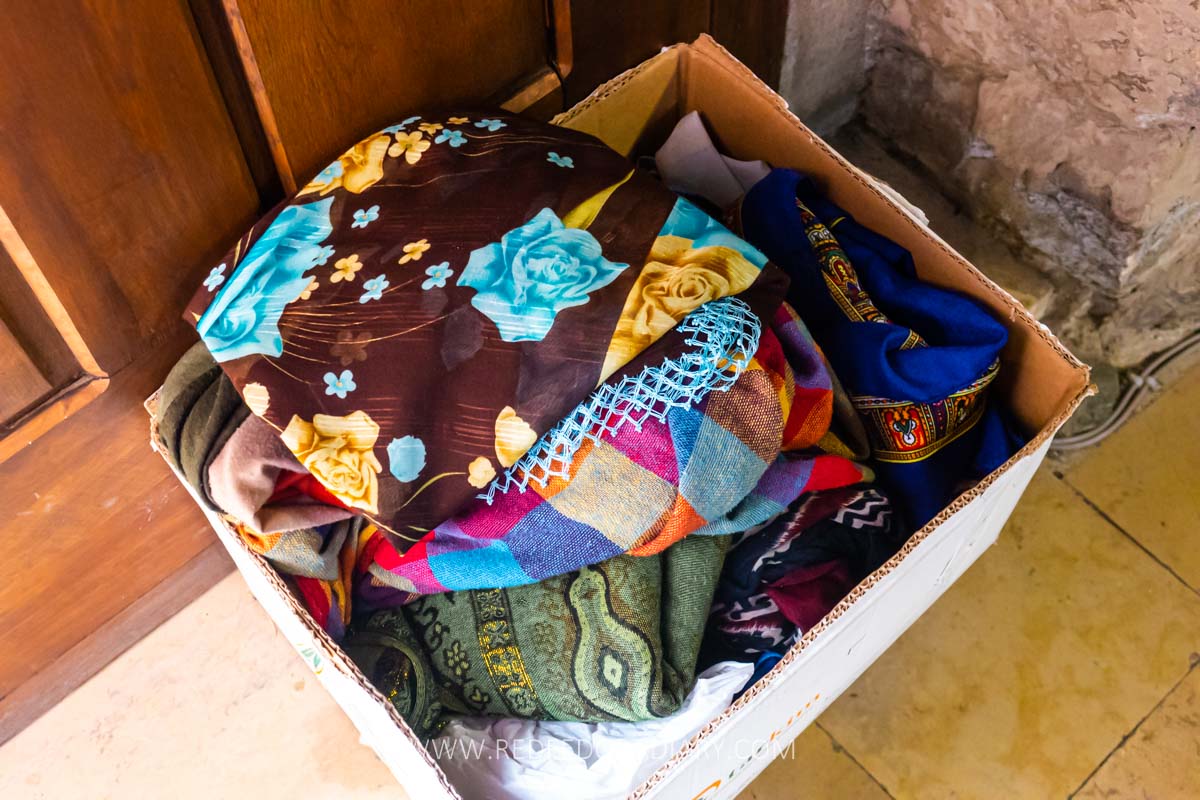
Pack a reusable water bottle, especially if you’re coming in summer — the heat can be intense. You’ll find plenty of kiosks and shops selling snacks and drinks, but it’s always easier (and more eco-friendly) to have your own water with you.
It’s also handy to keep small change in your pocket. Churches often have candles for sale or donation boxes, while local market stalls typically only accept cash. There are a couple of ATMs in town if you need them.
Mtskheta cafes and restaurants
If you plan to stay in town for lunch or dinner, there are plenty of Mtskheta restaurants and cafes that combine good food with beautiful views. Here are a few solid choices for your quick caffeine fix or a hearty meal.
Salobie (Bean House) – I’ve already covered this iconic spot above, but it deserves a mention here too in case you missed it. Open since 1967, Salobie is famous for its clay-pot lobio (bean stew). Pair it with mchadi cornbread and pickles for the full experience at this classic Mtskheta restaurant.
Ornament Express – This spot easily boasts the best views in Mtskheta, with a terrace that overlooks the Svetitskhoveli Cathedral. The menu features a mix of Georgian classics and lighter options, making it one of the most popular restaurants in Mtskheta.
Restaurant Check-In Garden – Expect hearty Georgian dishes, generous portions, and reasonable prices. The riverside location makes it a pleasant place to sit down in the garden after sightseeing.
Cafe Floria – Located close to the Mtkvari River, it has charming outdoor seating for warm days and unique décor with large qvevri clay vessels, we use for winemaking. The menu features mainly Georgian cuisine, and the views of Jvari Monastery make it one of the most atmospheric cafes in Mtskheta.
Tsiskvili Mtskheta – A branch of the well-known Tbilisi chain, this riverside restaurant offers a classic Georgian dining experience. With views of the Mtkvari River, Jvari Monastery, and surrounding hills, it’s a solid choice if you want a sit-down meal with a reliable, traditional menu.
Ada Cafe – Another riverside option with open views of Jvari and the Mtkvari, it mixes Georgian meals with fresh fish and Turkish pide.
Hotels in Mtskheta to stay overnight
Gino Wellness Mtskheta: Lakeside hotel and spa with an outdoor pool, wellness facilities, and mountain views — a good choice if you want to combine sightseeing with relaxation.
Tatin – Hotel and Cafe in Mtskheta: Small boutique-style stay with modern rooms above a cozy cafe, just a short walk from Svetitskhoveli Cathedral.
Old Capital: Centrally located guesthouse with a homely feel, offering comfortable rooms and easy access to Mtskheta’s main landmarks.
Hotel Bagineti: Mid-range option in the Old Town with spacious, well-kept rooms and a convenient location for exploring Mtskheta on foot.
